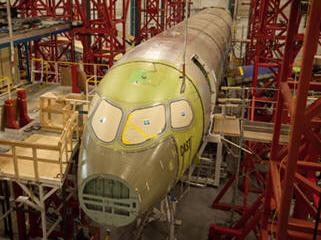|
With regard to the wings for the CSeries aircraft, Mr.
Dewar said “Subsequent to the extensive research and
test program at Bombardier Aerospace Belfast, which was
used to optimize the final production design for weight
and performance for the wings, the CAST will be used to
confirm their static strength along with that of the
other components of the airframe.”
The CSeries aircraft wings were built at Bombardier’s
new, state-of-the-art 600,000-sq.-ft. (55,742-sq.-m)
manufacturing and assembly facility in Belfast, Northern
Ireland, which is responsible for the design,
manufacture and integration of the advanced composite
wings for the CS100 and CS300 jets, including all flight
control surfaces and high-lift systems. The
use of resin impregnation has enabled the manufacturing
of larger and more complex composite structures in the
aviation industry. Bombardier Aerospace Belfast has been
at the forefront of that manufacturing revolution,
developing and patenting its unique Resin Transfer
Infusion (RTI) process that is now being used in
manufacturing the primary structural components of the
wings for the CSeries aircraft.
The use of composites in such a large structure as the
wing provides weight savings, but additional benefits to
customers include fewer inspections and therefore lower
maintenance costs, thanks to the corrosion resistance
properties and fatigue strength of the composite
material. The composite manufacturing process being
employed at Bombardier Aerospace, Belfast also permits a
high degree of accuracy and aero smoothness to minimize
drag and therefore reduce the CSeries aircraft’s fuel
burn. The advanced technology, carbon-fiber
wings for both the CS100 and CS300 aircraft have an
approximate area of 1,209-sq.-ft. and a span of 115 ft.
1 in. While some of the internal parts for the wings of
the two models will be different, they have the same
aerodynamic profile.
During the CAST, the wing and other components of the
airframe will be subjected to a series of load cases
representing flight maneuvers, landing, take-off and
other in-flight and on-ground conditions to test the
strength of the airframe.
For selected load cases, internal cabin pressure
will also be applied when simulating in-flight
conditions. Data collected will be monitored by
Bombardier’s stress engineers, as well as by the
partners and suppliers that are involved in the
development of structural components for the CSeries
aircraft.
As
in the production of the wings for the CSeries aircraft,
Bombardier has capitalized on its expertise in
composites technology in the development of the
airliner’s aft fuselage. For the carbon-fiber aft
fuselage, including the pressure dome, the company is
utilizing Automated Fiber Placement (AFP) techniques.
Bombardier's adaptation of AFP technology, which is also
utilizing robotic technology, has benefited from the
largest collaborative aircraft structures demonstration
project initiated by Canada’s National Research Council
to advance AFP use in the aerospace industry.
Bombardier is employing a brand new moving line in
manufacturing the cockpit for the CSeries aircraft at
its St-Laurent facility. The line has been designed
using lean manufacturing principles in order to ensure
safety for the company’s employees, enhance product
quality and provide flawless execution for on-time
delivery. CSeries aircraft, designed for the
growing 100- to 149-seat market, the 100 per cent new
CSeries aircraft family combines advanced materials,
leading-edge technology and proven methods to meet
commercial airline requirements in 2013 and beyond.
Powered by Pratt & Whitney PurePower PW1500G engines,
the CSeries aircraft family will offer a 15 per cent
cash operating cost advantage and a 20 per cent fuel
burn advantage.
The CSeries aircraft’s clean-sheet design will permit
the aircraft to achieve greatly reduced noise and
emissions, as well as superior operational flexibility,
exceptional airfield performance and a range of 2,950
nm. The CSeries aircraft will be up to 12,000 lbs (5,443
kg)** lighter than other aircraft in the same seat
category and will provide passengers with a
best-in-class, widebody cabin environment in a
single-aisle aircraft. The 13 customers that
have joined the CSeries aircraft program, nine with firm
orders – include major network carriers, national
carriers, premium airlines serving city centre airports,
a low-cost airline, leasing companies and a full service
provider to airline partners. Bombardier has booked
orders and commitments for 352 CSeries aircraft.
|



